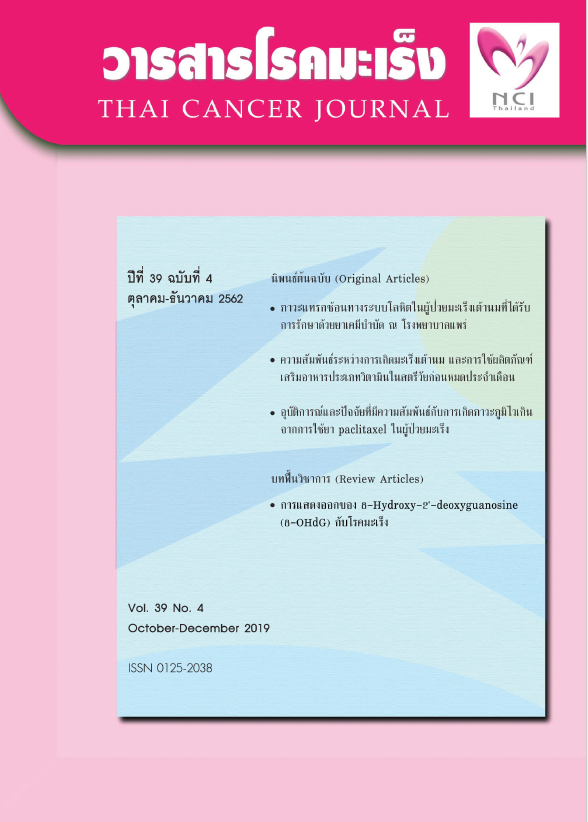Incidence and Risk Factors for Paclitaxel Hypersensitivity in Cancer Chemotherapy
Keywords:
paclitaxel, hypersensitivity, allergy, chemotherapyAbstract
Hypersensitivity reaction (HR) is still a major concern during cancer chemotherapy with paclitaxel. The objective of this study was to determine the incidence and factors associated with hypersensitivity reactions among cancer patients undergoing paclitaxel monotherapy at the National Cancer Institute, during the period June to December 2016. A retrospective study was performed involving a total of 200 patients (198 female;2 male) treated with paclitaxel monotherapy. The results showed that 35 patients (20.20%) experienced paclitaxel hypersensitivity reaction, with most of severity grades 1-2. Common symptoms were hot flush (68.57%), chest pain (65.71%), high blood pressure (37.14%), back pain or arthralgia (20.00%) and rash (2.86%). Hypersensitivity has been found among patients from their first paclitaxel administration, and repeated every chemotherapy cycle. In this study, the factors significantly associated with paclitaxel hypersensitivity reaction were patient’s age and chemotherapy cycle. The findings showed that the occurrence of hypersensitivity increased among elder patients (P=0.049) and patients who underwent early chemotherapy cycles (P<0.01). Our findings revealed that paclitaxel hypersensitivity was prevalent among patients during chemotherapy. Therefore, the healthcare team should give patients appropriate advice about the drug and basic observation as well as close monitoring during administration. From a policy perspective, hypersensitivity-reaction guidelines and systematic reporting of adverse drug reaction events during chemotherapy should be established for better prevention
References
แนวทางปฏิบตัใินการป้องกนัการเกิดภาวะ Hypersensitivity reaction. เข้าถึงได้จาก: http://110.164.68.234/news_raja/uploaded/Hypersensitivity%20reaction.pdf. สืบค้นเมื่อวันที่ 24 กุมภาพันธ์ 2560.
Hypersensitivities. Italy: Universitadeglistudi di pavia; 2009. Available from: http://nfs.unipv.it/nfs/minf/dispense/immunology/lectures/files/hypersensitivities.html. Accessed April 2, 2017.
Kingsley CD. Hypersensitivity Reaction. In: Perry Mc, ed. The Chemotherapy Source Book. 4th ed. Philadelphia: Lippincott Williams & Wilkins; 2008:152-73.
ทะเบียนมะเร็งระดับโรงพยาบาล Hospital-Based Cancer Registry. Thailand: National Cancer Institute; 2017. Available from: http://www.nci.go.th/th/File.download/NCi%20regristry/HOSPITAL-BASED%20 2016%Revise%204%20final.pdf. Accessed February 28, 2018.
Breast Cancer: NCCN Guideline (National Comprehensive Cancer Network; Clinical Practice Guideline in Oncology) version 1.2018 Chemotherapy for Advance or metastatic disease.
สุภัสร์ สุบงกช, จักรพันธ์ อยู่ดี, พิชญ์จิรา สงวนบุญญพงษ์. Drug Monograph. ใน: สุภัสร์ สุบงกช และคณะ, บรรณาธิการ. ค่มูือมาตรฐานการทำงานเกี่ยวกับยาเคมีบำบัดและการดูแลผู้ป่วยหลังได้รับยา. กรุงเทพฯ: นิวธรรมดาการพิมพ์; 2560. หน้า 278-80.
Bragalone DL. Drug information handbook for oncology. 9th edition. Ohio: 2011.
Boulanger J, Borusiquot JN, cournoyer G, Lemieux J, Masse MS, Almanric K, et al. Management of hypersensitivity to platinum-and taxane-based chemotherapy: CEPO review and clinical recommendations. Curr Oncol 2014;21:e630-e641.
Sendo T, Sakai N, Itoh Y, Ikesue H, Kobayashi H, Hirakawa T, et al. Incidence and risk factor for paclitaxel hypersensitivity during ovarian cancer chemotherapy. Cancer Chemother Pharmacol 2005;56:91-6.
Vogel WH. Infusion reactions: diagnosis, assessment, and management. Clin J Oncol Nurs 2010;14: E10-21.
Downloads
Published
Issue
Section
License
บทความทีตีพิมพ์ในวารสารโรคมะเร็งนี้ถือว่าเป็นลิขสิทธิ์ของมูลนิธิสถาบันมะเร็งแห่งชาติ และผลงานวิชาการหรือวิจัยของคณะผู้เขียน ไม่ใช่ความคิดเห็นของบรรณาธิการหรือผู้จัดทํา







